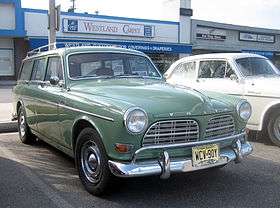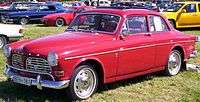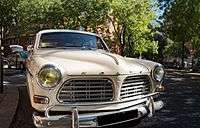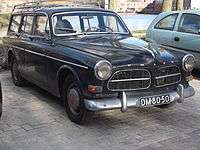Volvo Amazon
| Volvo Amazon | |
|---|---|
 | |
| Overview | |
| Manufacturer | Volvo Cars |
| Also called |
Model names: Volvo 121 [1] Volvo 122 [1] Volvo 123GT [2] Volvo 131 [3] Volvo 132 [4] Volvo 133 [1] Volvo 221 [1] Volvo 222 [1] Volvo 223 [1] Volvo Canadian [5] Bodystyle codes: 120/130/220 [2] |
| Production | 1956–1970 |
| Assembly |
|
| Designer | Jan Wilsgaard |
| Body and chassis | |
| Class | Large family car (D) |
| Body style |
|
| Layout | FR layout |
| Powertrain | |
| Engine | |
| Transmission | |
| Dimensions | |
| Wheelbase | 2,590 mm (102.0 in) |
| Length |
4,395 mm (173.0 in) to 4,450 mm (175.2 in); 4,490 mm (176.8 in) (estate) |
| Width | 1,620 mm (63.8 in) |
| Height | 1,505 mm (59.3 in) |
| Curb weight | 2,400 lb (1,100 kg) |
| Chronology | |
| Predecessor | Volvo PV444/544 |
| Successor |
Volvo 140 Series Volvo 164 |

The Volvo Amazon is a mid-size car manufactured and marketed by Volvo Cars from 1956 to 1970[7] and introduced in the USA as the 122S at the New York International Auto Show in April 1959.[8]
The Amazon shared the wheelbase, tall posture and high H-point seating of its predecessor, the PV and was offered two-door sedan, four-door sedan, and a five-door wagon body styles. In 1959 Volvo became the world's first manufacturer to provide front seat belts as standard equipment — by providing them on all Amazon models,[8] including the export models[8] — and later becoming the first car featuring three-point seat belts as standard equipment.
When introduced, the car was named the Amason (with an 's'),[7] deriving from the fierce female warriors of Greek mythology, the Amazons. German motorcycle manufacturer Kreidler had already registered the name, and the two companies finally agreed that Volvo could only use the name domestically (i.e., within Sweden), modifying the spelling to Amazon.[7] Subsequently, Volvo began its tri-digit nomenclature and the line became known as the 120 Series.[7]
The Amazon was originally manufactured at Volvo's Lundby plant in Gothenburg and subsequently at the company's Torslandaverken plant,[9] which began operating in 1964. By the end of production, 234,653 four-door models, 359,917 two-door models and 73,220 station wagons had been produced, of which 60% were exported;[8] for a total of 667,791 vehicles.
Styling and design
The Amazon sedan's ponton genre, three-box styling was inspired by US cars of the early 1950s, strongly resembling the Chrysler New Yorker sedan and the Chrysler 300C hardtop Coupe. According to designer Jan Wilsgaard, the Amazon's styling was inspired by a Kaiser he saw at the Gothenburg harbour.[10]
The Amazon featured strong articulation front to rear, pronounced "shoulders", and slight but visible tailfins. These features became inspiration for Peter Horbury when reconceiving Volvo's design direction with the V70 after decades of rectilinear, slab-sided, boxy designs.[11]
The Amazon's bodywork was constructed of phosphate-treated steel (to improve paint adhesion) and with heavy use of undercoating and anti-corrosive oil treatment.[12]
Station wagon
The station wagon (estate) version was introduced at the 1962 Stockholm Auto Show, and Volvo manufactured 73,000 examples between 1962 and 1969.[13] The Amazon estate featured a two-piece tailgate, with the lower section folding down to provide a load surface and the upper section that hinged overhead. The vehicle's rear license plate, attached to the lower tailgate, could fold "up" such that when the tailgate was lowered and the vehicle in use, the license plate was still visible. This idea was used by the original 1959 Mini. In recent years a similar arrangement was used on the tailgate of the Subaru Baja.
The Amazon platform was used as the basis for the P1800 and 1800ES.[14]
History
Under prototype designation 1200, following the PV444's internal designation as the 1100,[8] the Amazon was released in the press in February 1956, with production initially set to begin in July of the same year, and deliveries commenced in August 1956 — under the now modified internal designation 120 series. Further iterations included the 121, the base model with a single carburetor 66 bhp (49 kW) engine, the 122S introduced in 1958 as a performance model equipped with a dual carburetor 85 bhp (63 kW) engine. The Amazon's handbrake location, outboard of the driver's seat, was intended to accommodate subsequent bench seat models with column shift transmissions — which never materialized. Buyers began to receive the first cars in February 1957,[8] and initial models were two-tone red and black with light gray roof, light grey with a black roof, followed by a dark blue with gray roof in 1958.[8]
In 1966 the Volvo PV ended production, replaced by the Amazon Favorit, a less expensive version of the Amazon, without exterior chrome trim, a passenger-side sunshield or cigarette lighter, and with a three-speed rather than four-speed transmission — available in black with red interior and later white or black with red interior.[8] The newer Volvo 140 was becoming the company's mainstream model, and the last of the four-door 120 saloons were produced in 1967.[15] In 1967 came the 123GT, which was a Model 130 with high-compression four-cylinder B18B engine (from the Volvo P1800), M41 gearbox, fully reclining seats, front fog and driving lights (on some markets), alternator, fender mounted mirrors, special steering wheel, dash with a shelf and tachometer, and other cosmetic upgrades. In 1969 the displacement of the old B18 engine was increased and the engine was called the B20.
The last Amazon was manufactured on 3 July 1970.
Features
Original specifications for the Amazon included the new Volvo B16 engine, a 3-speed manual gearbox (H6) and rear-wheel drive. In 1958 the sport model, Amazon Sport, was released and later the same year the Amazon became the first series produced car with a three-point safety belt in the front seats as standard. In 1962, Volvo introduced a two-door version, a five-door wagon, and the new B18 engine, deleting two-tone paint and upholstery. In 1965 the Amazon color-coordinated embossed vinyl upholstery and door panels became available. The new gearbox selections were the three-speed M30 (briefly offered with an automatic electric clutch), the four-speed M40 and the M41 with four-speed and overdrive. The M31 gearbox was also introduced in 1961 but was only available that year (a three-speed fully synchronized gearbox with overdrive on both second and third direct gears). Gearbox options on the 121 were the M30, M31 and M40 while gearbox options on the 122S were the M40 and M41 gearboxes. In 1964 the Borg-Warner BW35 three-speed automatic transmission also became available on the four-door and two-door. From 1967 to 1968 the BW35 was also available on the five-door wagon.
 Volvo P 12104 4-Door Sedan 1959
Volvo P 12104 4-Door Sedan 1959 Volvo P12106 Amazon 4-door Sedan 1960
Volvo P12106 Amazon 4-door Sedan 1960 Volvo 133351 M Amazon Sedan 1967
Volvo 133351 M Amazon Sedan 1967 Volvo 221341 S Amazon Station Wagon Police 1969
Volvo 221341 S Amazon Station Wagon Police 1969
 Volvo Amazon Sedan Police 1970
Volvo Amazon Sedan Police 1970 Volvo 131341 T Amazon Sedan 1970
Volvo 131341 T Amazon Sedan 1970 Volvo 131341 T Amazon Sedan 1970
Volvo 131341 T Amazon Sedan 1970 A Saab 96 (left) and a Volvo Amazon (right) line up to race.
A Saab 96 (left) and a Volvo Amazon (right) line up to race.
 Classic Hill climb in the Alps Volvo 122S
Classic Hill climb in the Alps Volvo 122S Volvo 120 B18 1967 photographed in 2000
Volvo 120 B18 1967 photographed in 2000- Volvo Amazon P22134 (P220), Amsterdam
- Volvo Amazon P22134, Amsterdam, 2014.
 Volvo Amazon in Paris, France, September 2016.
Volvo Amazon in Paris, France, September 2016.
References
- 1 2 3 4 5 6 Volvo 120 series, 1961-70 autobook, trove.nla.gov.au Retrieved 18 October 2016
- 1 2 John Smith, Profile on the Volvo 120 Amazon, www.volvoclub.org.uk Retrieved on 27 May 2013
- ↑ Volvo 131 Autocar Road Test, www.flickr.com Retrieved 18 October 2016
- ↑ Volvo advertisement, Autocar, 21 October 1966, page 32
- ↑ Sales brochure for Volvo Canadian, 1800S & 544, www.canadiancar.technomuses.ca Retrieved 18 October 2016
- ↑ "Volvo assembly plants". Volvoadventures.com. 8 August 2008. Retrieved 1 June 2012.
- 1 2 3 4 "The Volvo Amazon: A Volvo beauty with mythological status turns 50". Volvoclub.org, 11 July 2006.
- 1 2 3 4 5 6 7 8 Lindh, Björn Erik (1986). "The Amazon/120 - Beauty with Brown". Volvo The Cars from the 20s to the 80s. Förlagshuset Norden AB, Malmö. pp. 130–141. ISBN 91-86442-14-7.
the new model was still known as the 1200 (the old PV444 having been the 1200"; "the announcement of the new car was released in the press in February 1956," "to introduce the new Amason (spelled with an 's' rather than 'z'); "Volvo were hoping to market export versions with a bench-type front seat and a column-mounted gear lever, and a handbrake located in the middle would have been in the way." "Amazon buyers began to receive their cars in February/March 1957, albeit at a very slow rate"; "The first Amazons were, in principle, not available in a single colour, although some were occasionally supplied. The cars were available in black and red with a light grey roof, and in light grey with a black roof. A dark blue finish with a light gray roof was added to the range in 1958"; "In the USA, the model was launched at the International Automobile Show in New York in April 1959"; "234,209 four-door, 359, 917 two-door and 73, 196 estate cars had been produced, 60% of them for export"; "the Company was unaware that Kreidler, the West German motorcycle manufacturer, had already registered the name. Following negotiations, the Company was permitted to use the name on the domestic market whereas, in other countries, the cars were known as the 121 or 122"; "The 1959 model (which appeared in August 1958) featured a major innovation in the form of front seat safety belts as standard equipment on all the cars, including the export models. Volvo was the world's first automaker to take this step, even though Ford fitted a "lap" belt on one or other of its cars in the middle of the 50s"; "Most of the external decoration (including the trim around the front and rear windows and along the gutters) was removed, while the interior was more austere, no sunshield being fitted on the passenger side and the cigarette lighter being omitted. There was only one technical modification; the normal 75hp engine was equipped with a three-speed fully synchronised gearbox. The Favorit was available only in black with a red interior (although a white finish was introduced subsequently.
- ↑ "From Mass-Market Cars to Niche Sports Utility Vehicles - The Volvo Torslanda Plant Turns 40". Swedespeed.com, 15 April 2004, Source: Volvo Car Corporation.
- ↑ "Så blev hon en bil" [How she became a car]. aftonbladet.se (in Swedish). Retrieved 8 July 2007.
- ↑ "Global Viewpoints: Design roots". SAE.org, Automotive Engineering Online, Global View, April 2000.
- ↑ "Volvo 122S: a rugged proved performer that even the toughest critics find difficulty in faulting". Life Magazine, 4 November 1956 (condensed from Car and Driver).
- ↑ "The Amazon Estate (P220)- The First Major Step Towards the Five-Door Saloon" (PDF). Volvoclub.org.
- ↑ "From the Past: Volvo 1800ES, Combination of a Wagon and Sports Car Flopped in the Market, but Became Influential". The Wall Street Journal,Dan Carney, 30 June 2007. Archived from the original on April 16, 2008.
- ↑ "Used car test: 1964 Volvo 122S B18". Autocar: 52–53. 15 February 1968.
External links
![]() Media related to Volvo Amazon at Wikimedia Commons
Media related to Volvo Amazon at Wikimedia Commons
- Volvo Amazon Buyers Guide, with advice on finding a good example
- Volvo Amazon Picture Gallery, including extensive production data
- Norsk Volvo Amazon Klubb
- Svenska Volvo Amazonklubben
- Amazonet - Homepage about Volvo Amazon
| « previous — Volvo Cars road car timeline, 1960s–present | |||||||||||||||||||||||||||||||||||||||||||||||||||||||||
|---|---|---|---|---|---|---|---|---|---|---|---|---|---|---|---|---|---|---|---|---|---|---|---|---|---|---|---|---|---|---|---|---|---|---|---|---|---|---|---|---|---|---|---|---|---|---|---|---|---|---|---|---|---|---|---|---|---|
| Type | 1960s | 1970s | 1980s | 1990s | 2000s | 2010s | |||||||||||||||||||||||||||||||||||||||||||||||||||
| 0 | 1 | 2 | 3 | 4 | 5 | 6 | 7 | 8 | 9 | 0 | 1 | 2 | 3 | 4 | 5 | 6 | 7 | 8 | 9 | 0 | 1 | 2 | 3 | 4 | 5 | 6 | 7 | 8 | 9 | 0 | 1 | 2 | 3 | 4 | 5 | 6 | 7 | 8 | 9 | 0 | 1 | 2 | 3 | 4 | 5 | 6 | 7 | 8 | 9 | 0 | 1 | 2 | 3 | 4 | 5 | 6 | |
| Small family car | 66 | 440/460 | |||||||||||||||||||||||||||||||||||||||||||||||||||||||
| 480 | C30 | ||||||||||||||||||||||||||||||||||||||||||||||||||||||||
| 544 | 340/360 | S40/V40 | S40/V50 | V40 | |||||||||||||||||||||||||||||||||||||||||||||||||||||
| Compact executive car | Amazon/120/130 | S60/V70 | S60/V60 | ||||||||||||||||||||||||||||||||||||||||||||||||||||||
| Duett | 140/145 | 240 | 850 | S70/V70 | |||||||||||||||||||||||||||||||||||||||||||||||||||||
| Executive car | 260 | 740 | 940 | S80 | S80/V70 | ||||||||||||||||||||||||||||||||||||||||||||||||||||
| 164 | 760 | 960 | S90/V90 | S90/V90 | |||||||||||||||||||||||||||||||||||||||||||||||||||||
| Sports saloon | 242 GT | 240 Turbo | 850 T-5R/R | S70 R/V70 R | S60 T5/V70 T5 | S60 R/V70 R | |||||||||||||||||||||||||||||||||||||||||||||||||||
| 2-door saloon/Shooting-brake | P1800 | 1800S | 1800E | 1800ES | |||||||||||||||||||||||||||||||||||||||||||||||||||||
| Coupé | 262C | 780 | C70 | C70 | |||||||||||||||||||||||||||||||||||||||||||||||||||||
| Crossover utility vehicle | XC60 | ||||||||||||||||||||||||||||||||||||||||||||||||||||||||
| V70XC | XC70 | XC70 | |||||||||||||||||||||||||||||||||||||||||||||||||||||||
| XC90 | XC90 | ||||||||||||||||||||||||||||||||||||||||||||||||||||||||

